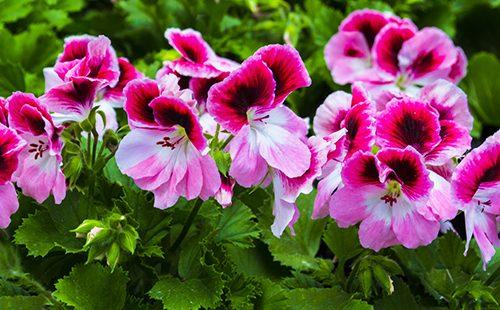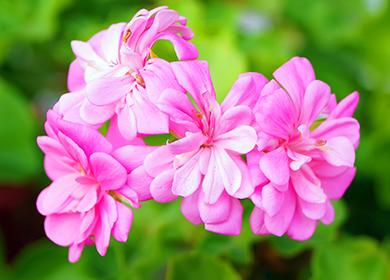The content of the article
Royal pelargonium (geranium) blooms only with proper care. In adverse conditions, the flower will not die, but the buds will not form. The efforts made will not be in vain - the flowering is very beautiful.
Description and Features
This is a powerful bushy royal plant half a meter high. Branched shoots, strong. The leaves are wide, with serrated edges. The surface is rough to the touch. The flowers are very large compared to other types of pelargonium. Their diameter can reach 7 cm. Purple, white, dark pink, and burgundy colors predominate in the colors. Petals are usually fringed, corrugated. Solid flowers are very rare, more often two shades are harmoniously combined in color.
Growing royal pelargonium at home is not an easy task. It grows quickly, rarely dies, but to preserve its decorativeness and make it bloom is difficult. The flowering period is shorter than that of "ordinary" pelargonium, is only three to four months. For laying flower buds, it is necessary to observe a cold wintering at a temperature of no higher than 12 ° C. Royal Pelargonium blooms in spring.
Royal Pelargonium Care: What to Consider
How to care for potted royal pelargonium? It is important to provide it with full lighting, a favorable temperature regime, and to find the optimal watering schedule in accordance with the conditions of detention. Experienced flower growers recommend that you adhere to the following rules.
- Temperature. In spring and summer, the optimum temperature is about 23-24 ° C. In the winter of the royal pelargonium, a rest period at 10-14 ° C is necessary. Cool wintering contributes to the abundant laying of flower buds in the spring. Keeping warm not only prevents flowering, but also weakens the plant.
- Lighting. The need for lighting is high not only in summer but also in winter. In summer, the plant receives the right amount of light due to the sun, in winter it is advisable to use fluorescent lamps. Without illumination, flower buds will not be laid.
- Watering. It is necessary to water the royal pelargonium, taking into account the conditions of detention. In the spring and summer, in the warm, they are watered sparingly, but often - in small portions twice a day. In winter, they simply maintain soil moisture, preventing its complete drying out. Only the topsoil should dry. For a single watering take about 50 ml of water. Experienced flower growers advise replacing the top watering with the bottom to avoid soil compaction.
- Humidity. It grows normally and blooms in dry air. Spraying harms pelargonium, leaves traces on its velvety leaves. Bathing in the shower flower is contraindicated.
- Top dressing. Introduce mineral fertilizers with weekly intervals.Before flowering, around the end of March, potash and phosphorus fertilizers are added. Pelargonium does not like organic matter. In winter, feeding is stopped.
- Priming. Preference is given to soils with a neutral or slightly alkaline reaction. A good composition is a mixture of an equal amount of sand, peat, turf, humus and leafy soil. It is useful to add ash - it reduces acidity, provides additional nutrients.
- Pot. Use ceramic pots. At each transplant, the size of the pot is taken a little larger - literally a couple of centimeters. Young, small plants are not planted in spacious pots - this is fraught with acidification of the substrate, rotting of the roots.
- Transfer. The interval between transplantations of adult pelargonium is two to three years. More often it is not necessary to transplant - a capricious variety can hardly tolerate transplants, flowering is postponed. The frequency of transplants depends on the growth rate. When the thin roots begin to break through the drainage holes, it is time to transplant.
Pruning rules
How to prune a plant? Royal Pelargonium should be cut to maintain a beautiful shape of the bush and full flowering. A common mistake is spring pruning. If you cut the pelargonium in the spring, it will transfer flowering for a year. Therefore, you need to form a bush only after flowering. Usually it ends in mid-summer, sometimes a little later.
Trimming is carried out twice with a monthly interval. After the first pruning, pelargonium will actively release new shoots. To stimulate further branching, pinch them after the fifth young leaf. Pinching is repeated up to five times to achieve a neat shape of the bush and the active formation of buds. The time for the last pinch is no later than the end of January.
Why no buds
Royal pelargonium does not bloom for various reasons. In most cases, common care errors affect.
- Temperature. Incorrectly selected temperature conditions, warm wintering. For the formation of flower buds in winter, pelargonium is kept cool.
- Lighting. Lack of lighting, especially in winter.
- Big pot. In a spacious pot, pelargonium lets out new shoots, grows leaves, but does not bloom.
- Power shortage. For flowering, two trace elements are needed - potassium and phosphorus. If not enough, buds will not form. Excess nitrogen gives the same effect.
- Incorrect pruning. Spring pruning postpones blooming for a year. You need to wait until the flowering ends and only then prune.
Breeding methods
How to propagate geraniums? The propagation of royal pelargonium by cuttings is mainly used. Seeds are used only in stores. Seeds collected from your plant will sprout, but the flowers will be smaller, lose their characteristic bright color.
Cuttings
Description. In order not to injure the plant once again, the cuttings are combined with pruning. Cut tops with three pairs of leaves are used. Root the royal pelargonium in the water does not work - the base of the handle will rot. Therefore, they are planted directly in the ground.
Procedure
- Before planting, the base of the cuttings is dipped in coal powder, dried for several hours.
- Deepen in a loose substrate.A mixture of equal amounts of sand and perlite or peat with sand is suitable. In order not to disturb the roots once again, it is better to immediately take separate glasses. According to some gardeners, it is convenient to use peat tablets.
- After rooting, the cuttings are carefully transplanted into larger diameter pots with nutrient soil. It’s better not to rush, to carry out the first transplant in a couple of months.
- Pinch over the third pair of leaves. Pinching is repeated as it grows.
Seeds
Description. Growing from seeds is used as a way to simultaneously obtain a large number of young plants. Use only store seeds.
Procedure
- Sowing begins near the end of winter. Seeds are sown in a light, loose substrate for shelter.
- Keep in good light, if necessary, illuminated with fluorescent lamps.
- Daily check the humidity of the substrate, remove condensate from the film or glass.

Common diseases
Diseases for royal pelargoniums pose a greater danger compared to other species. The table shows the most common ailments and methods for their treatment.
Table - Diseases of the Royal Pelargonium
| Disease name | Signs of infection | Treatment methods |
|---|---|---|
| Gray rot | - Brown spots on the leaves; - gray fluffy coating | - Transplantation into a new sterile soil; - pruning of affected parts; - treatment with fungicides "Vitaros", "Fundazol" |
| Stem and root rot | - Blackening of the root neck; - pallor, yellowness, lethargy of leaves | Processing “Fitolavin”, “Biporam” |
| Late blight | - Slowdown of growth; - pallor of leaves; - dented spots on stems | - Trimming to healthy tissue; - treatment with any fungicides; - transplantation into a sterile substrate |
| Eden (swelling of the tissues) | Bumps and growths on the leaves | - Cutting sick leaves; - reduction of watering |
| Verticillus wilting | Leaves fade but remain hanging on the stem | - Destruction of affected plants; - at the initial stages - treatment with the preparations "Fundazol", "Topsin" |
The main problems of growing
No less problems arise due to improper care or inappropriate conditions of detention. The most common growth defects and their causes are shown in the table.
Table - Problems of growing royal pelargonium
| Problem | Possible reason |
|---|---|
| Leaves turn yellow | - lack of moisture; - excess watering; - excess fertilizer; - lack of light |
| Blush Leaves | Cold |
| The bottom of the stem is exposed | Lack of sunlight |
| The soil dries quickly, and the leaves wither | Close pot |
| Mold appears on the surface of the soil | Dense soil |
| No bloom | - Incorrect pruning; - a spacious pot; - warm wintering |
| Buds fall | - Drafts; - heat; - complete drying of the soil |
Knowing how to care for the royal pelargonium, you can achieve a stable and long flowering. Beautiful, large terry flowers will please even those who before that did not really like pelargonium.

